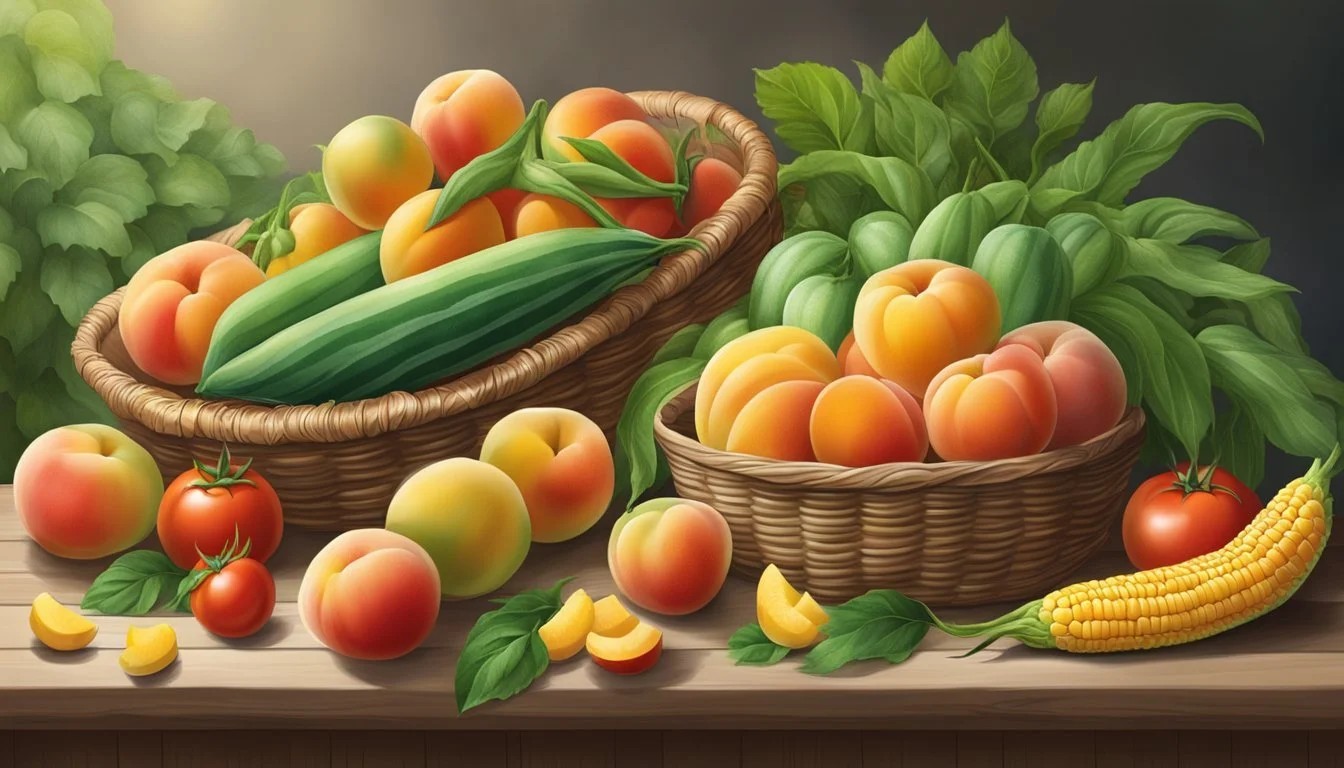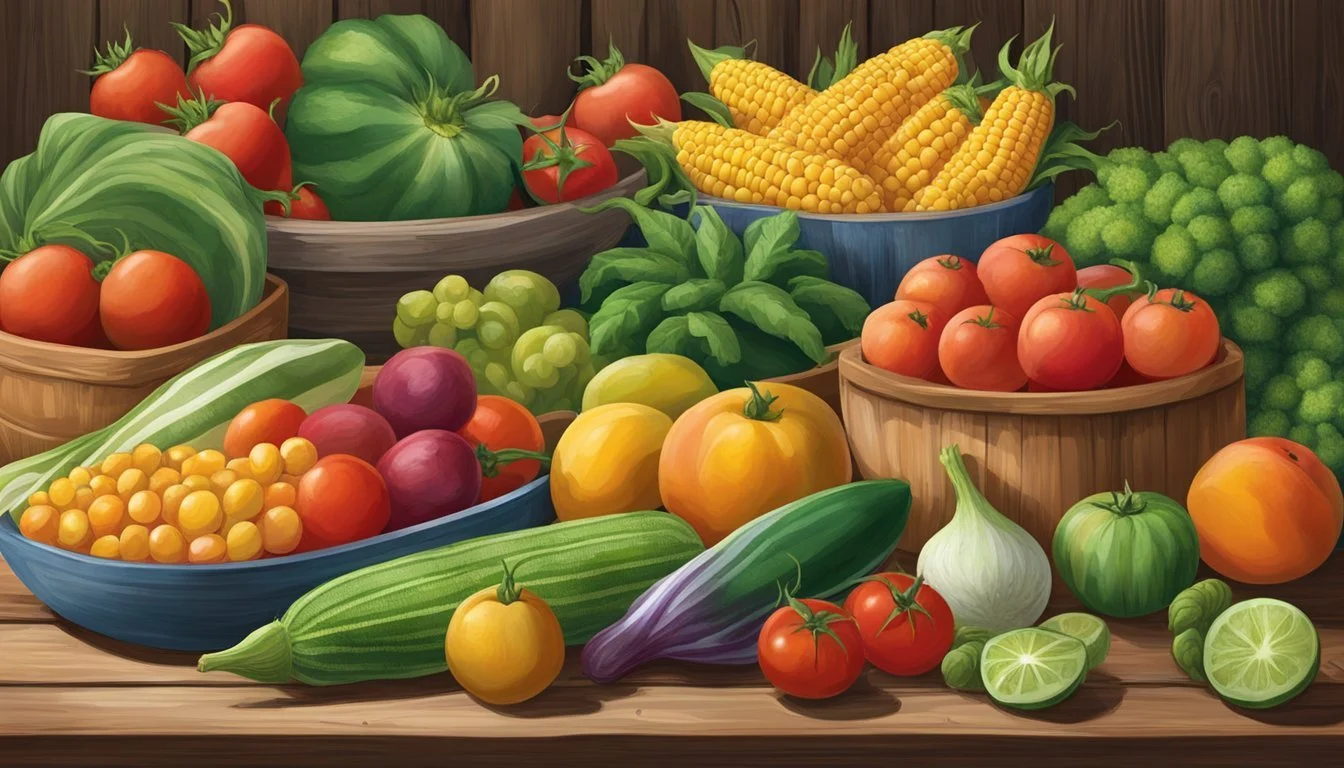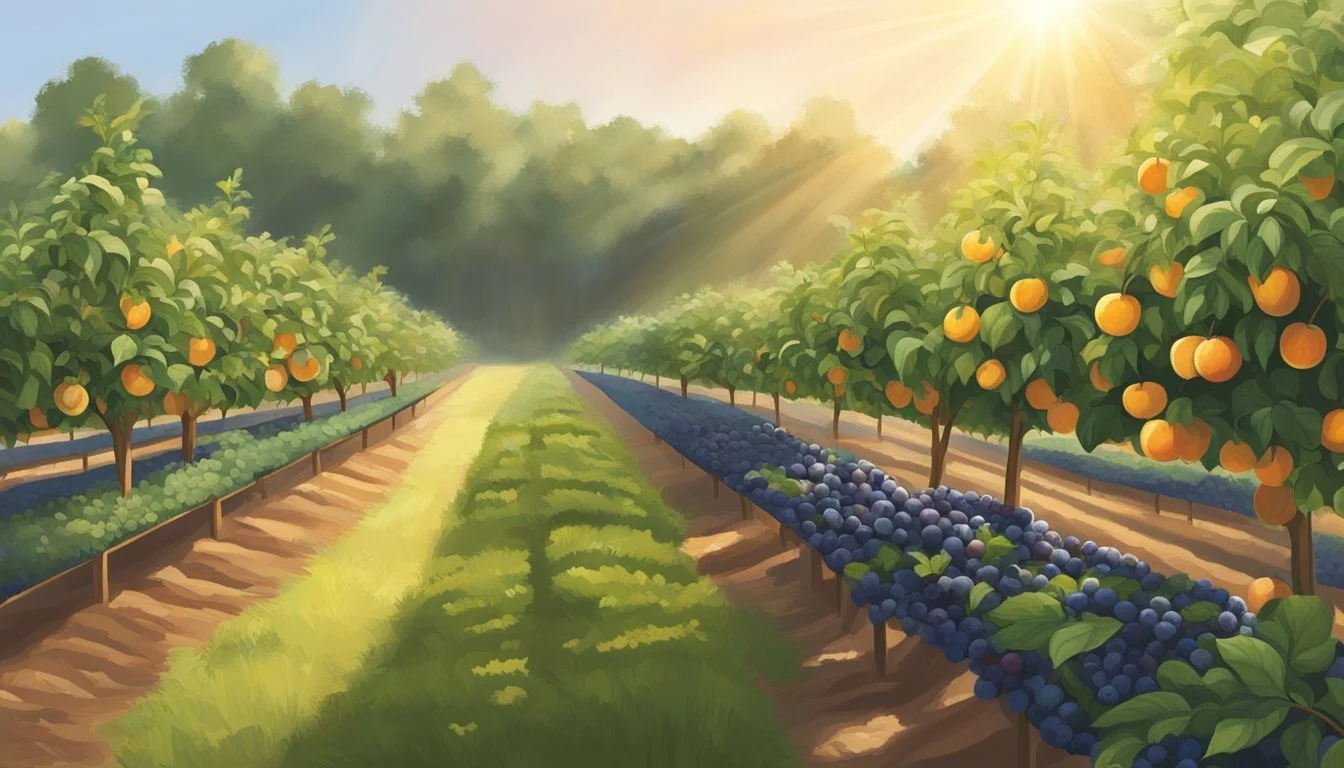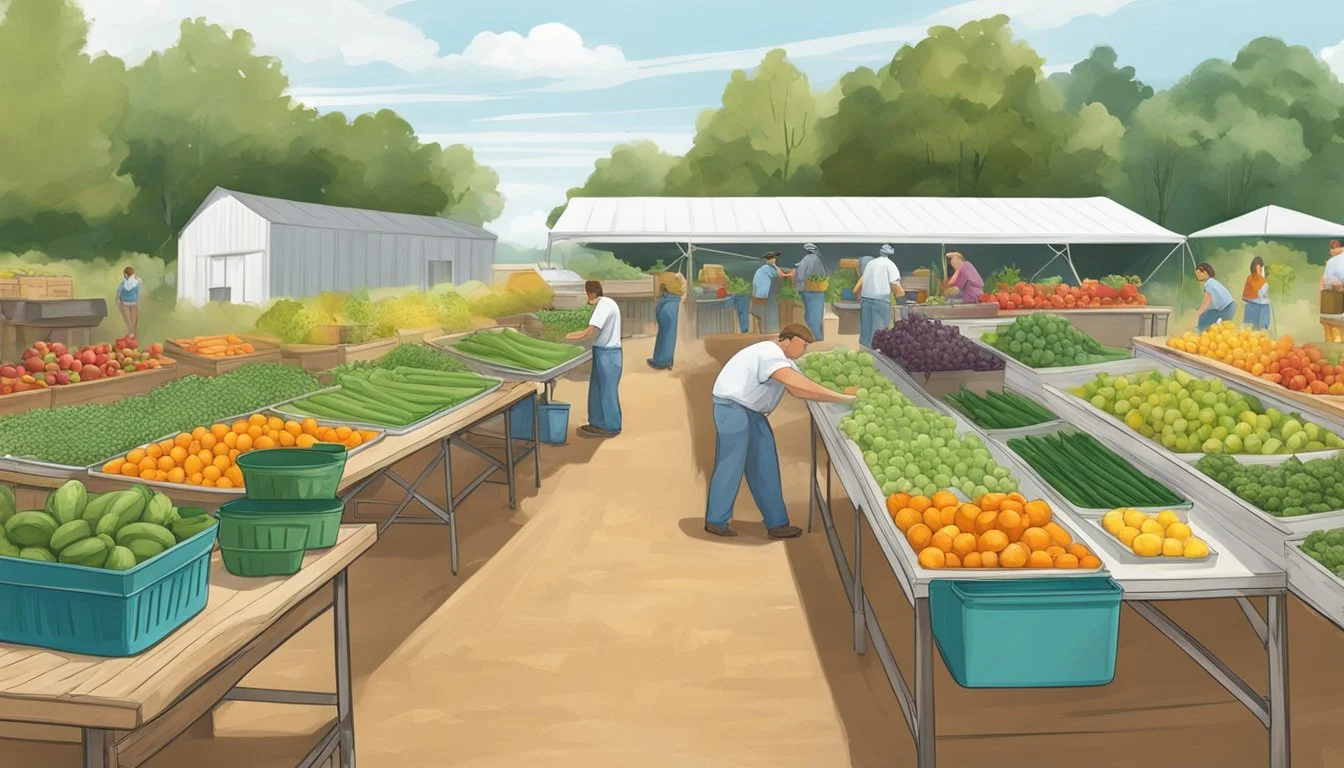Alabama Seasonal Fruit & Vegetables in July
Your Fresh Picks Guide
This Article is Part of our Alabama Seasonal Fruit & Veg Calendar
Alabama enjoys a rich tapestry of fruits and vegetables that flourish throughout the year thanks to its favorable climate. July, in particular, stands out as a peak month for a variety of produce. During this time, the state's agriculture bursts into full productivity, offering an abundance of fresh and flavorful options.
With the summer heat at its zenith, July in Alabama marks the harvest season for a cornucopia of fruits like peaches, blueberries, and blackberries, which reach their optimal ripeness. These fruits are joined by a selection of vegetables that thrive in the warm weather, including tomatoes, sweet corn, and okra, all staples of Southern cuisine that are celebrated for their taste and nutritional value.
Local farmers' markets and roadside stands become bustling hubs of activity as residents and visitors alike seek out the freshest local produce. The season brings an opportunity to enjoy these foods at their peak, often harvested within hours of reaching the market, thus offering an exceptional culinary experience rooted in the regional landscape.
Overview of Alabama's Seasonal Produce in July
In July, Alabama's farms offer a bounty of fruits and vegetables, reflecting the state's diverse agricultural capabilities. This month's warmth contributes to the peak season for many crops, allowing for an abundant harvest of summer produce.
Fruits: July is prime time for sweet and juicy fruits in Alabama. Residents and visitors can enjoy:
Peaches: Juicy and ripe, they are a Southern summer favorite.
Blueberries: These berries are at their plump and flavorful peak.
Watermelons: Synonymous with summer, they are refreshingly sweet.
Blackberries: Perfect for pies, these berries are ripe for the picking.
Each of these fruits is synonymous with not just Alabama, but with the essence of summer itself, providing the flavors that define the season.
Vegetables: As for vegetables, July brings many nutritious options to the table:
Tomatoes: Both heirloom and conventional varieties are in ample supply.
Corn: Sweet and bi-color varieties are perfect for grilling.
Cucumbers: (how long do cucumbers last?) Crisp and cool, ideal for fresh salads.
Peppers: A variety of peppers, from bell to the spicier kinds, are available.
Okra: A staple in Southern cooking, it's ready for frying or stewing.
This is just a snapshot of the vibrant produce that Alabama offers in July. Local markets and roadside stands across the state showcase these seasonal selections, emphasizing fresh, locally-grown fruits and vegetables.
Key Vegetables Available
In July, Alabama's soil bursts with a bounty of fresh vegetables. Gardeners and farmers markets abundantly showcase these seasonal gems, ensuring residents have access to peak freshness and flavor.
Summer Staples
Alabama's summer warmth nurtures a variety of staple vegetables known for their versatility in the kitchen. These staples include:
Okra: Thriving in the heat, it's perfect for gumbos or fried dishes.
Beans: Various types, like snap beans, are crisp and ready for harvest.
Squash: Yellow squash and zucchini are abundant, excellent for sautéing.
Cucumbers: Refreshing and crisp, ideal for salads or pickling.
Eggplant (What wine goes well with eggplant?): Deep purple and versatile, eggplant is great for grilling or in casseroles.
Late July Vegetables
As the month progresses, certain vegetables arrive at their peak:
Tomatoes: Bright and full-flavored, tomatoes are ripe for the picking.
Peppers: From sweet bell to spicy varieties, peppers add color and kick to dishes.
Fruit Harvest Calendar
In July, Alabama's agricultural landscape offers a flavorful bounty, with farms bustling with activity as various fruits reach peak ripeness.
Berries and Stone Fruits
Blueberries are in full swing in July, as they typically are harvested from mid-June through late July. Farmers and consumers alike find this period optimal for picking these nutritious berries. Blackberries also share the spotlight, with their season often spanning from June to August, making July a prime month for harvesting these rich, dark fruits.
Peaches, a hallmark of stone fruit season, are another July favorite in Alabama. Stone fruits, characterized by their pit and fleshy exterior, are synonymous with summer, and peaches often hit their peak during this month.
Melon Varieties
When it comes to melons, July is the month where they come into their prime. Watermelon, a classic symbol of Southern summer refreshment, tends to be ripe for picking in Alabama from July through September. The expansive fields become dotted with these large, green gourds, promising sweet, hydrating fruit inside.
Other melon varieties also join the harvest calendar, though watermelons are the standout variety that brings quintessential summer joy to picnics and gatherings across the state. With their high water content and sweet flesh, these melons are not only a treat to taste but also provide respite from the Alabama heat.
Gardening Tips for July in Alabama
With July's high temperatures, gardeners in Alabama face challenges yet have opportunities for planting and maintenance to ensure a healthy and productive garden.
Planting Schedule
In Alabama, July is not the peak planting month for most crops due to the intense heat; however, gardeners can still plant certain heat-tolerant vegetables. For a successful harvest, one should consider the following planting options:
Vegetables: Okra, Southern peas, and sweet potatoes can be planted as they thrive in the warm soil of July.
Herbs: Heat-tolerant herbs such as basil (how long does basil last?) and oregano can be established for late summer use.
Before planting, gardeners should check the soil temperature as some seeds require a warm soil to sprout properly.
Maintenance and Care
Maintenance activities in July are crucial to the health and productivity of the garden:
Watering: Plants require consistent moisture. They should be watered deeply and early in the morning to prevent evaporation.
Mulching: Applying a layer of mulch helps retain soil moisture and keeps roots cool.
Pruning: Remove spent blooms (deadheading) and any diseased or dead foliage to encourage new growth and prevent plant diseases.
Fertilizing: Lightly fertilize plants if needed, but avoid heavy fertilization which can stress plants during high temperatures.
Soil Testing: Mid-summer is a good time to test soil to adjust pH and nutrient levels for fall planting.
Pest Control: Monitor for pests and diseases regularly and take necessary actions to control them without harming beneficial insects.
One must be cautious with garden care during the scorching days of July to maintain a bountiful and vibrant garden.
Health Benefits of Seasonal Eating
Eating seasonally means selecting fruits and vegetables that are naturally at the peak of their supply in the local area. They taste better and are typically more nutrient-dense than produce that is out of season. These foods have ripened fully and naturally before being harvested, which helps to ensure the highest quality in terms of both flavor and nutritional value.
Nutrient-Rich: Seasonal produce often contains an optimal mix of nutrients. For example, fruits and vegetables picked during their appropriate seasons may have higher levels of vitamins and antioxidants.
Improved Flavor: When fruits and vegetables are grown and picked at their proper times, the flavors are often more robust and the textures more appealing. Consumers typically enjoy the true flavors of fresh produce, as opposed to items that have traveled great distances and may have lost their taste quality.
Optimum Freshness: Seasonal eating promotes consumption of items at their maximum freshness. This means that produce has not been stored for long periods of time, which can lead to a degradation in nutrient content and taste.
Variety and Creativity: Eating with the seasons requires consumers to vary their choices throughout the year, often leading to more diverse and creative meals.
Selected Seasonal Produce in Alabama for July:
Vegetables: Sweet Corn, Tomatoes, Cucumbers
Consumers can maximize their health benefits by focusing on these seasonal offerings, which are abundant in July in Alabama. They will enjoy heightened flavors, increased nutrient profiles, and the joy of eating produce picked at the height of its natural growth cycle.
Horticulture Education and Resources
In Alabama, individuals seeking knowledge on seasonal fruits and vegetables for the month of July can access a wealth of information through university programs and extension services that provide education and practical guidance.
University Guidance
Auburn University stands at the forefront of horticultural education, offering extensive resources for those interested in seasonal produce. Kerry Smith and Frances Sledge, serving respectively as an Extension Associate and Horticulture Intern, contribute to the University's outreach by educating the public on optimal seasonal gardening practices. Auburn's horticulture programs are tailored to deliver up-to-date information that reflects the latest research findings in the field.
Extension Services
The Alabama Cooperative Extension System is a valuable resource that extends Auburn University's educational reach to the wider public audience. Dave Williams, former Extension Horticulturist, and Ron Shumack, who reviewed the material, have played significant roles in providing research-based information applicable for both commercial producers and home gardeners. They offer practical guidance to ensure successful cultivation and harvest of fruits and vegetables, specifically tailored to Alabama's unique climate and soil conditions during July's growing season.
Season-Extending Techniques
In Alabama, growers can extend the production of fruits and vegetables beyond the traditional growing season using various season-extending techniques. These methods enable earlier starts in the spring, prolonged harvests into fall, and even some winter production.
Protective Structures
High Tunnels and Hoop Houses: These structures are unheated, plastic-covered enclosures that provide a protective layer between the crops and the external environment. By controlling temperature, reducing moisture loss, and shielding plants from excessive rain or pests, high tunnels can extend the growing season for many crops.
Cold Frames and Hot Beds: For smaller-scale production, cold frames, which are insulated boxes with transparent lids, offer a microclimate for early-sown spring crops or to protect late-season produce from early frosts. Hot beds, additionally, use an internal heat source to raise the soil's temperature, allowing for earlier planting in spring or later growing into fall.
Growing Season Timeline
Spring: Protective structures can be utilized to start the planting of more tender fruits and vegetables earlier than the last expected frost date, enabling a head start to the season.
Summer: To protect against the intense summer heat and prevent bolting or wilting, shade cloths can be employed. This allows for the extension of crops like leafy greens that would otherwise struggle in peak summer temperatures.
Fall: As temperatures cool, structures like high tunnels help maintain a more consistent and warm environment, enabling the harvest of summer crops like tomatoes and peppers well into the fall.
Winter: Though more challenging, certain cold-hardy crops can continue to grow in high tunnels or with the use of row covers to provide additional warmth, possibly yielding a harvest even in the coldest months.
Season Technique Benefit Spring Early planting with heat Jump-start on tender crops; protection from late frosts Summer Shade cloths Protection from heat; extends leafy green production Fall High tunnels/hoop houses Warmer environment for extended harvest Winter High tunnels with row covers Enables growth of cold-hardy vegetables
By using these techniques, farmers and gardeners in Alabama can significantly expand the window for cultivating a larger variety and quantity of produce outside the conventional timelines.
Food Preservation and Preparation
In July, Alabama's abundance of fresh produce presents the perfect opportunity for home preservation. This allows residents to enjoy the local flavors year-round and provides a foundation for a variety of culinary creations.
Canning and Freezing
Canning is an excellent way to preserve the tangy flavors of Alabama tomatoes and the sweetness of July peaches. One should follow proper sterilization methods and use a pressure canner for vegetables like green beans to prevent spoilage and foodborne illnesses.
Freezing is simpler and can retain freshness in fruits like blueberries and blackberries.
Tomatoes: Blanch, then peel before canning.
Peaches: Peel and treat with ascorbic acid to prevent browning before freezing.
Green Beans: Use a pressure canner for canning; for freezing, blanch and cool before storing in airtight containers.
Recipe Ideas
Fresh produce in Alabama is perfect for varied recipes. Salads with cucumbers and tomatoes are refreshing, while soups featuring okra can be a comforting summer meal. One might consider roasting sweet corn for enriching flavor before incorporating it into salads or sides.
Tomato Basil Salad: Combine fresh tomatoes, basil, and mozzarella, then drizzle with balsamic reduction.
Okra Soup: Sauté okra with onions and garlic, add broth, and simmer to make a hearty soup.
Roast Sweet Corn: Preheat the oven and roast corn until tender, then season with salt, pepper, and butter.
By utilizing these preservation methods and incorporating fresh produce into culinary practices, home cooks can savor the essence of Alabama's July harvest and expand their recipe repertoire.
Community Engagement and Social Media
In July, Alabama's agricultural community thrives on sharing information about fresh, seasonal produce through local events and online platforms. These interactions play a critical role in educating consumers about what is currently available and how to incorporate these items into their meals.
Local Events
Local farmers' markets and festivals in July offer an up-close experience with Alabama's seasonal fruits and vegetables. They often use Facebook event pages to announce dates, featured products, and activities. These events encourage community participation and provide opportunities for direct engagement with local farmers.
Online Platforms
Producers and consumers frequently turn to social media to connect over Alabama's fresh produce. Farmers utilize Facebook posts and Twitter feeds to share updates about the harvest, offer preparation tips, and promote special offers. On these platforms, they can also engage in real-time with their audience, answering questions and gathering feedback about their produce.









